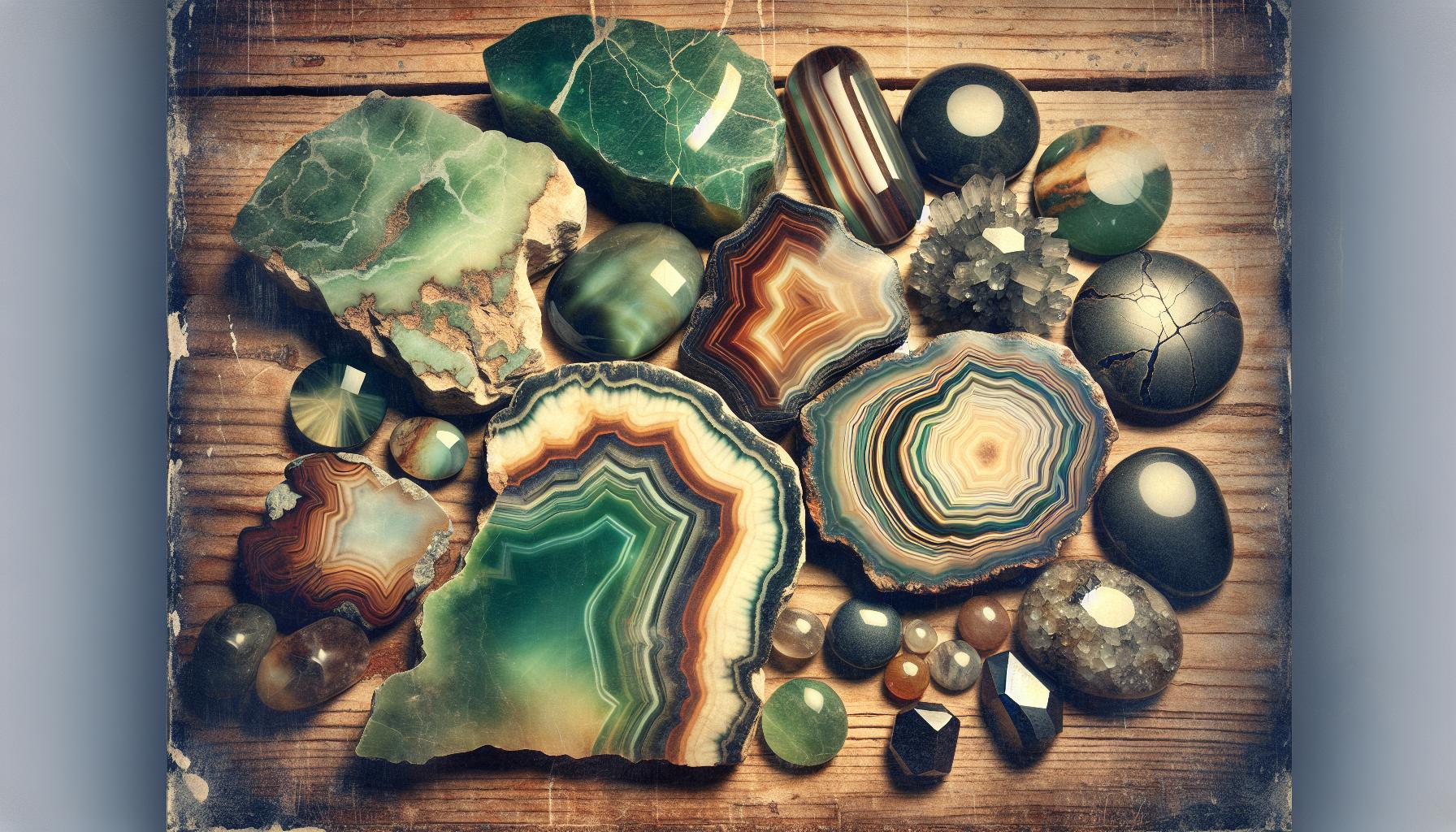Michigan’s diverse geology makes it a hidden gem for rockhounds searching for unique treasures.
From the shores of the Great Lakes to the Upper Peninsula’s ancient bedrock, you’re in for a real adventure.
You’ll discover Petoskey stones, Lake Superior agates, and copper bounties that are as rich in history as they are in beauty.
Get ready to explore the best spots where each find is a piece of Michigan’s geological puzzle.
In Michigan, rockhounding enthusiasts can explore diverse locations like Keweenaw Peninsula for copper, Lake Superior shores for agates, and Petoskey for fossilized coral. Other sites include the Driftless Area, rich in minerals and fossils, and Central Wisconsin quarries for quartz and calcite. Get permission for quarry access.
Michigan Rockhounding Locations
When you’re ready to embark on your rockhounding adventure in Michigan, knowing where to start is key. The state’s varied landscape offers a wealth of locations where you can unearth geological gems. Armed with a sturdy pair of gloves, a durable hammer, and unwavering patience, you’re all set to explore some of Michigan’s most prolific spots.
Keweenaw Peninsula, in the Upper Peninsula, is renowned for its abundant copper deposits. At this historic mining area, you can scour tailings piles for nuggets and float copper pieces. The locals are well-versed in the area’s geological gifts and can often provide tips to newcomers eager to catch a glimpse of Michigan’s copper wealth.
Heading down to the shores of Lake Superior, rockhounds find an array of colorful Lake Superior agates. These banded beauties are best searched for after a storm, when fresh waves and winds churn up new treasures. The beach town of Grand Marais is a particularly popular spot, providing both picturesque views and fertile hunting grounds.
Petoskey, Michigan, embodies its name by offering the iconic Petoskey stones—fossilized coral pieces with a distinctive pattern. The best season to find these stones is spring, especially after the winter ice has retreated, revealing what’s been hidden beneath.
For those who enjoy sifting through the sands, the dunes around Manistee and Ludington could yield fruitful results. Ample presence of corals and freshwater fossils make these areas a fascinating stop for enthusiasts.
Here’s a quick reference for top rockhounding locations and their common finds:
| Location | Common Finds |
|---|---|
| Keweenaw Peninsula | Copper, Datolite, Quartz |
| Lake Superior | Lake Superior Agates, Jasper, Chert |
| Petoskey | Petoskey Stones, Fossilized Coral |
| Manistee | Fossils, Petoskey Stones, Beach Glass |
| Ludington | Horn Coral, Fossils, Petoskey stones |
What Gemstones are Found in Michigan?

When you’re traversing the scenic landscapes of Michigan, your curiosity might be piqued about the variety of gemstones the state offers. Michigan’s geology is a treasure trove, rich with gems that are not only beautiful but also hold a place in the area’s mining history.
Greenstone, also known as chlorastrolite, is Michigan’s state gem. Highly prized for its unique turtleback pattern, it’s primarily found in the Upper Peninsula along the shores of Isle Royale National Park. However, note that rock collecting in the National Park is prohibited, so you’ll want to keep an eye out for this gem in the neighboring areas.
Avid collectors often seek out Michigan’s Datolite, which captivates with its array of colors and crystal forms. The best spots for finding datolite are in the copper mines of the Keweenaw Peninsula, where its presence accompanies rich copper ores. The presence of copper can give datolite a striking pink or red hue, making any find particularly exciting.
For those fascinated by the night sky, the state offers a unique gem reminiscent of the cosmos – Michigan’s Lake Superior agates. These banded beauties possess a celestial blend of colors, and are most often recovered on the beaches along Lake Superior, especially following stormy weather that churns the lake’s sands.
If you’re aiming to add some shimmer to your collection, Hematite and Quartz Crystals are also hidden within Michigan’s soil. Hematite, with its metallic luster and high iron content, is commonly located in the Marquette Range, while clear, rose, and smoky quartz can be unearthed in various parts of the state, including the Upper Peninsula mines.
Remember to familiarize yourself with the local laws and obtain necessary permissions before rockhounding, ensuring you enjoy your hunt responsibly and sustainably. With these details in mind, your expedition to uncover Michigan’s geological wonders promises to be both enriching and thrilling.
What Sedimentary Rocks You Can Find in Michigan?

Venturing into the world of sedimentary rocks in Michigan, you’re likely to uncover a stunning variety of treasures. Fossils are a sedimentary rock enthusiast’s dream, and in Michigan, fossilized corals are commonly found. These remnants of ancient seas are most prevalent in the rock units of the Traverse Group, which is exposed in the northwestern part of the Lower Peninsula.
Another intriguing find is Petoskey stones, the state stone of Michigan. Petoskey stones are fossilized coral that has been shaped and smoothed over time by glacial activity and wave action. They’re most often found on the beaches of Lake Michigan and Lake Huron, especially near the city of Petoskey.
For those with a sharp eye, finding Limestone and Dolomite deposits is quite likely. These rocks are primarily made of calcite and dolomite minerals, and can contain an abundance of fossils. The Michigan Basin is a key location for these sedimentary rocks, where they are used extensively in road construction and cement creation.
In your journey, don’t overlook Shale, a fine-grained sedimentary rock that’s typically found in many of the state’s ancient sedimentary deposits. Shale formations in Michigan often contain natural gas and are part of the state’s energy resources.
- Traverse Group: Fossilized corals
- Lake Michigan and Lake Huron beaches: Petoskey stones
- Michigan Basin: Limestone and Dolomite
- Ancient sedimentary deposits: Shale
As you explore these areas, keep in mind that each region has its own regulations regarding rock collection. Always check local guidelines and respect private property rights. With a little persistence and respect for the law, you’ll discover that Michigan’s geological treasures are as enriching as they are diverse.
What Metamorphic Rocks are found in Michigan?
When you’re exploring the rich landscape of Michigan, you’ll discover that the state is a treasure trove for metamorphic rock enthusiasts. Metamorphic rocks are those that have been transformed by extreme heat and pressure from their original form into new types of rock.
Slate, a finely foliated metamorphic rock, can be found in the Upper Peninsula, particularly in the vicinity of Ishpeming. This rock originated as shale and got compressed and heated, changing its structure. If you visit the area, you’ll also come across schist, recognizable by its shiny, mineral-rich layers. This rock displays evidence of the intense geological forces that shaped the region over millions of years.
Gneiss, with its distinctive banded pattern, comprises part of Michigan’s metamorphic rock collection. Its bands symbolize layers of different minerals that have undergone metamorphosis. You can stumble upon this stunning rock near Marquette, an area that has revealed its geological history through these formations.
Additionally, marble, another sought-after metamorphic rock, exists within Michigan’s geological mosaic. Often sourced for its beauty and used in sculpture and architecture, marble in Michigan attests to the ancient limestone deposits that were subjected to heat and pressure, transforming into the elegant rock prized by collectors and artisans alike.
To find these metamorphic treasures, you’ll want to gear up and head to regions known for their exposed rock formations. Always remember to obey property rights and take precautions to ensure a safe and legal rockhounding adventure.
Whether you’re an avid collector or a curious newcomer, Michigan’s diverse range of metamorphic rocks provides a fascinating glimpse into the dynamic processes that shape our planet. As you embark on your rockhounding journey, keep your eyes peeled for these metamorphic marvels that tell a story of pressure, time, and transformation hidden beneath the surface.
What Igneous Rocks can You Find in Michigan?
Venturing into the diverse geological landscape of Michigan, you’ll discover that igneous rocks are widespread and equally fascinating as their metamorphic counterparts. These rocks are formed from the solidification of molten magma which originates deep within the Earth’s crust or from volcanic activity.
Common Types of Igneous Rocks in Michigan
Michigan is home to various igneous rocks, each with its own unique set of properties and origins. Some of the most common types you’re likely to encounter include:
- Basalt: Often found in the ancient bedrock of the Upper Peninsula, basalt is typically a dark, fine-grained rock that formed from lava flows.
- Granite: Renowned for its durability and aesthetic appeal, granite can be spotted in the form of boulders or exposed bedrock throughout the state.
- Diabase: This is a dolerite rock that’s easily mistaken for basalt but can be differentiated by its slightly coarser texture.
Prime Locations for Igneous Rockhounding
For those eager to see these rocks in their natural setting, here are prime spots to begin your search:
- Isle Royale: Located in Lake Superior, this island and national park is a treasure trove of basalt formations.
- Keweenaw Peninsula: Famous for its copper deposits and splendid exposures of basalt and granite.
When planning your rockhounding excursion, remember:
- Seasons matter: Spring and fall are ideal for rockhounding as the snowmelt and lower vegetation cover make rocks more visible.
- Permissions are mandatory: Always get permission if venturing on private lands and stick to collecting where it’s legally permitted.
Panning for Gold in Michigan
While Michigan isn’t the first place that springs to mind when you think of gold mining, the state holds its own hidden treasures. Gold panning in Michigan is a lesser-known activity, but it can yield surprising results for patient prospectors. Glacial movements scattered gold deposits throughout the state, particularly in its northern parts.
Upper Peninsula hotspots like the Ropes Gold Mine or the areas around Marquette provide the best chances to find gold. You’d want to focus on streams and river beds where gold, being a dense mineral, tends to settle. The process of panning involves swishing sediment in a shallow pan with water to separate the gold from less dense materials.
When you venture out to pan for gold, here’s what you need to know:
- Equipment: A standard gold panning kit usually includes a pan and a classifier. It’s recommended to have a shovel and a small suction tool for gathering material.
- Technique: Practice the art of swirling the pan just enough to allow the gold to sink to the bottom while lighter materials are washed away.
- Regulations: Ensure you’re panning in public lands or have acquired permission on private properties. Familiarize yourself with the Michigan Department of Natural Resources guidelines to prevent any legal issues.
Though gold flakes and small nuggets are typical finds, don’t set your expectations too high; the real reward is often in the serenity of nature and the thrill of the hunt. For enthusiasts willing to explore, the Lower Peninsula also offers possibilities, especially in the sands along Lake Michigan’s shoreline.
Remember, consistent technique and patience are key in gold panning. Try different locations if one spot doesn’t yield results. Joining local prospecting clubs can also provide access to better locations and a community of like-minded individuals passionate about this unique aspect of rockhounding in Michigan.
Rocks and Minerals Found in Michigan
As you explore the diverse terrains of Michigan, you’ll find an array of rocks and minerals that are as fascinating as the state’s gold panning history. The varied geological regions of Michigan, from the ancient bedrock of the Upper Peninsula to the glacial deposits of the Lower Peninsula, offer a rich tapestry of specimens for rockhounds like you.
Among the most coveted finds in Michigan are the Petoskey Stones, the state stone, which are actually fossilized coral. These unique stones can be found along the beaches of Lake Michigan and Lake Huron, shining with a distinct pattern that is highly sought after by collectors.
On your rockhounding expeditions, you may also come across Michigan Greenstones. These rare gemstones, also known as chlorastrolite, are particularly associated with the Keweenaw Peninsula and Isle Royale. Their vibrant green hue, with intricate, web-like patterns, can make any finding a highlight of your trip.
In addition to the state gem, several types of quartz can be found throughout Michigan, including:
- Clear quartz
- Amethyst
- Agate
- Jasper
Each type boasts its own unique colors and patterns, providing a thrilling hunt for eye-catching pieces. The Keweenaw Peninsula, especially, is a historic mining area where you can unearth native copper and Datolite with its vivid colorization and glass-like appearance.
If you’re into collecting fossils, Michigan won’t disappoint. The state’s ancient seabeds are littered with fossilized remains of corals, trilobites, and crinoids. Discovering these remnants from millions of years ago can be as panoramic as glimpsing into the past.
In your search, you’ll also want to dig for common and uniquely Michigan minerals such as:
- Hematite
- Magnetite
- Celestine
- Gypsum
Keep in mind, many of these treasures are scattered around the state in different rockhounding sites. Whether you’re sifting through riverbeds or scouring old mine tailings, each find adds to the allure of Michigan’s geological diversity. Remember to always seek permission where necessary, and adhere to the rockhound’s code of ethics to “take only pictures, leave only footprints.” This way, you ensure that these sites remain untouched for future generations of explorers.
Where Can I Find Fossils in Michigan?
Fossils, the preserved remains of ancient life, provide a fascinating glimpse into Michigan’s distant past. If you’re interested in uncovering these natural treasures, you’re in luck—Michigan’s fossil locations are as diverse as the fossils themselves.
One of the most prominent areas to find fossils in Michigan is the Rockport State Recreation Area. Here, you can discover remnants of prehistoric creatures that lived over 400 million years ago during the Devonian period. Keep your eyes peeled for fossils of corals, brachiopods, and trilobites hidden among the limestone. Remember, at Rockport, collecting is permitted and you’re allowed to take home up to 25 pounds of fossils per year.
Next on the list is Alpena’s Fossil Park, located at the Lafarge Quarry. Thanks to the exposed layers of limestone, this park is another hot spot for Devonian era fossils. Alpena’s Fossil Park is especially family-friendly, offering a safe environment where even novice rockhounds can unearth fossils with ease.
For those keen on finding a wider variety of fossils, the Thumb Area of Michigan is a must-visit. The area is known for an abundance of fossils like petoskey stones, horn corals, and crinoids stemming from ancient sea beds. A notable site within this region is the Turnip Rock area, which is accessible by kayak.
In the southwest part of the state, Grand Ledge is renowned for its fossil-rich shale formations. While the layers of sediment make it a bit more challenging to extract these specimens, the journey is worth it for dedicated fossil enthusiasts.
Before heading out on your adventure to these fossil-rich locations, it’s critical to check local rules and guidelines. Many areas have specific regulations regarding fossil collection to ensure these historical sites are preserved for future generations. Always respect these guidelines and practice responsible collection methods to maintain the integrity of these natural archives.
Whether you’re a seasoned rockhound or just starting, Michigan’s array of fossil sites provides ample opportunity for exciting discoveries. Keep in mind that patience and persistence are key when searching for fossils. They’re waiting to be found, offering a tangible connection to the ancient worlds that once thrived in the Great Lake State.
Michigan Rockhounding Laws & Regulations
When you’re planning to explore the rich geological sites of Michigan, understanding the local rockhounding laws and regulations is imperative. Whether you’re combing through the beaches for Petoskey stones or hunting for ancient fossils, eyes peeled, regulations are in place to protect the environment and preserve the history imbedded in these natural treasures.
First and foremost, you should be aware that taking rocks, minerals, or fossils from national parks is illegal. Adhering to the Lacey Act, which prohibits the removal of any natural objects from federal land, could save you from hefty fines and legal headaches. Moreover, it’s your responsibility to make sure you’re not trespassing on private property when rockhounding.
On state-owned lands, including state parks, recreation areas, and forests, you’re generally allowed to collect rocks and fossils for personal use, as per the Michigan Department of Natural Resources (DNR). However, there are restrictions. Typically, a daily limit of 25 pounds plus one specimen applies, but you cannot legally sell anything you collect on these lands. Also, keep in mind that the use of motorized equipment in collecting is usually prohibited to avoid disturbing the land.
In specific rockhounding hotspots, local rules may further dictate what’s permissible. For example:
- Rockport State Recreation Area: Collection is often allowed but check for any seasonal restrictions.
- Alpena’s Fossil Park: You’re free to take home what you can find, but hammering into the solid rock is not allowed.
A good practice is to visit the official websites or contact the DNR for the latest information before planning your trip. They can provide detailed guidance and any necessary permits for collecting. Additionally, respected rockhounding clubs often have up-to-date insights and may arrange group outings with permissions in place.
Here are some essential steps to follow:
- Verify land ownership and confirm if rockhounding is allowed.
- Obtain any necessary permits.
- Follow collection limits and guidelines.
- Respect nature by practicing “Leave No Trace” principles.
Familiarizing yourself with these guidelines not only ensures your rockhounding adventure is legal but also helps preserve Michigan’s geological heritage for future enthusiasts.
Rockhounding Tips for Beginners in Michigan
Gearing Up: Essential Tools for Rockhounding
Before you set off on your Michigan rockhounding adventure, you’ll need to gather some essential tools. Accurate gear will make your excursion both productive and enjoyable. First, a durable geologist’s hammer or a rock pick is your primary instrument for chipping away at rock formations and prying open crevices. Second, don’t overlook a good pair of gloves to protect your hands from sharp edges and rough surfaces. Third, bring along sturdy containers or bags to transport your finds, being attentive to avoid damage during transit.
Additional tools might include:
- A hand lens or magnifier for close inspection of minerals
- A small brush to clean off debris from your finds
- Chisels and pry bars for more intricate extractions
- A GPS device or detailed maps to navigate remote areas
These items will provide the foundation for a successful rockhounding expedition in Michigan’s diverse geological landscapes.
Safety Tips While Rockhounding
Prioritizing your safety is crucial when rockhounding. Always wear protective gear like a helmet, especially when working in areas where falling rocks are a hazard. Additionally, invest in a pair of safety goggles to shield your eyes from flying debris. It’s important to stay aware of weather conditions, as sudden changes can pose risks, particularly in open or remote areas.
Here’s a rundown of safety practices:
- Inform someone of your plans and expected return time
- Carry a first aid kit for unforeseen injuries
- Stay hydrated and bring sufficient water and snacks
- Wear appropriate clothing, including sturdy boots with ample ankle support
By adhering to these safety measures, you can ensure your rockhounding journey is as safe as possible.
Legal Guidelines for Rockhounding Enthusiasts
As you venture out to explore Michigan’s rich geological offerings, it’s essential to understand and follow the legal guidelines in place. Firstly, never collect on private property without permission from the landowner. Doing so not only respects the rights of property owners but also protects you from potential legal consequences.
On public lands, the rules can be quite specific. Here’s a brief outline:
| Public Land Type | Collection Limitations | Equipment Restrictions |
|---|---|---|
| State Parks | Typically, personal use only | Hand tools often allowed; motorized prohibited |
| National Parks | Not permitted | N/A |
| Bureau of Land Management Areas | Varies; permits may be required | Varies; generally more allowed than in Parks |
Remember, rules can change, and specific hotspots often have unique regulations, so it’s wise to check with the Michigan Department of Natural Resources before your trip. By doing so, you ensure that your rockhounding activities are legal and ethical.
Conclusion: Michigan Rockhounding Guide & Map
Embarking on your rockhounding adventure in Michigan, you’re now equipped with the know-how to make the most of your treasure-hunting excursions.
Remember to prioritize safety, respect the legalities, and always be prepared with the right gear. With Michigan’s rich geological landscape at your fingertips, you’re set to uncover the hidden gems that lie beneath its surface.
Happy hunting!







